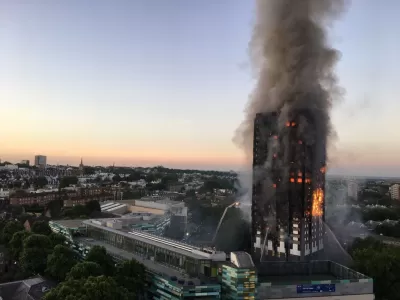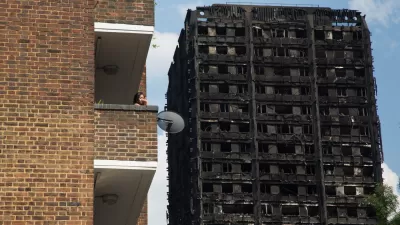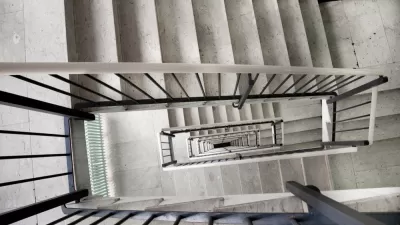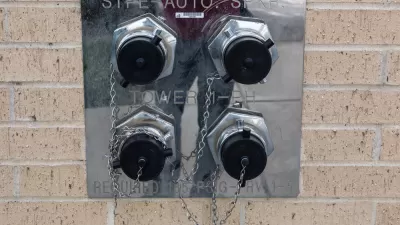Fire safety experts are rushing to explain the horrific scene in London's Kensington neighborhood last night—after a fire destroyed a residential high rise. The building was recently retrofitted to meet efficiency standards.

Oliver Wainwright and Peter Walker write: "'A disaster waiting to happen,' is how the architect and fire expert Sam Webb describes hundreds of tower blocks across the UK, after the fire at Grenfell Tower in Kensington that has left at least six people dead." [As of this writing, the fatality total has reached 12, but it is expected to increase.]
Webb is a leading expert on fire safety after surveying residential tower blocks for a report to the Home Office in the early 1990s. At the time, more than half of hundreds of buildings didn't meet basic fire safety standards.
"I really don’t think the building industry understands how fire behaves in buildings and how dangerous it can be. The government’s mania for deregulation means our current safety standards just aren’t good enough," Webb is quoted saying in the article.
A terrible aspect of the tragedy at Grenfell Tower, according to another source cited in the article, "is the flammability of insulation panels that are being used to clad postwar buildings to bring them up to date with today’s thermal standards." Grenfell Tower recently underwent a "£8.7m refurbishment of Grenfell Tower saw the building clad with 'ACM cassette rainscreen' panels, an aluminium composite material covering insulation panels, which could have caused the fire to spread more quickly up the facade of the tower."
FULL STORY: 'Disaster waiting to happen': fire expert slams UK tower blocks

Planetizen Federal Action Tracker
A weekly monitor of how Trump’s orders and actions are impacting planners and planning in America.

Congressman Proposes Bill to Rename DC Metro “Trump Train”
The Make Autorail Great Again Act would withhold federal funding to the system until the Washington Metropolitan Area Transit Authority (WMATA), rebrands as the Washington Metropolitan Authority for Greater Access (WMAGA).

The Simple Legislative Tool Transforming Vacant Downtowns
In California, Michigan and Georgia, an easy win is bringing dollars — and delight — back to city centers.

The States Losing Rural Delivery Rooms at an Alarming Pace
In some states, as few as 9% of rural hospitals still deliver babies. As a result, rising pre-term births, no adequate pre-term care and "harrowing" close calls are a growing reality.

The Small South Asian Republic Going all in on EVs
Thanks to one simple policy change less than five years ago, 65% of new cars in this Himalayan country are now electric.

DC Backpedals on Bike Lane Protection, Swaps Barriers for Paint
Citing aesthetic concerns, the city is removing the concrete barriers and flexposts that once separated Arizona Avenue cyclists from motor vehicles.
Urban Design for Planners 1: Software Tools
This six-course series explores essential urban design concepts using open source software and equips planners with the tools they need to participate fully in the urban design process.
Planning for Universal Design
Learn the tools for implementing Universal Design in planning regulations.
Smith Gee Studio
City of Charlotte
City of Camden Redevelopment Agency
City of Astoria
Transportation Research & Education Center (TREC) at Portland State University
US High Speed Rail Association
City of Camden Redevelopment Agency
Municipality of Princeton (NJ)





























